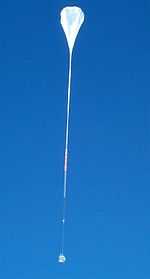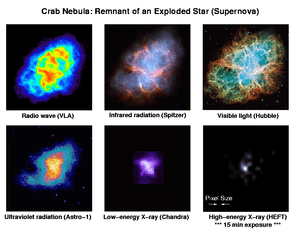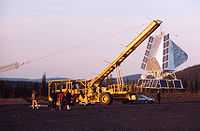Astronomy/Balloons
< AstronomyBalloons provide a long-duration platform to study any atmosphere, the universe, the Sun, and the near-Earth and space environment above as much as 99.7 % of the Earth's atmosphere. Unlike a rocket where data are collected during a brief few minutes, balloons are able to stay aloft for much longer. Balloons for astronomy offer a low-cost, quick-response method for conducting scientific investigations. They are mobile, meaning they can be launched where the scientist needs to conduct the experiment, in as little as six months.
Astronomy
With appropriate calibrations for the atmosphere at or above a circumnavigational glider or superballoon, astronomical observations should be at least as good as those from satellites at much lower cost.
Balloons
The Ultra Long Duration Balloon (ULDB) Project is developing new composite materials and a new balloon design, a standard gondola including power, global telemetry/command and an altitude control system. The ULDB is seeking to improve mission control and operations and the integration of scientific instruments. It is the potential for longer duration flights that has been the driver for the resurgence of interest in balloons by the scientific community. In recent years, the manned global ballooning attempts have called attention to the difficulty of achieving “longer”.
Planetary science
"Research balloons are balloons that are used for scientific research. They are usually (though not always) unmanned, filled with a lighter-than-air gas like helium, and fly at high altitudes."[1]
Cosmic-rays
The various background effects OSO 1 encountered prompted the flight of similar detectors on a balloon to determine the cosmic-ray effects in the materials surrounding the detectors.
Positrons
Measurements "of the cosmic-ray positron fraction as a function of energy have been made using the High-Energy Antimatter Telescope (HEAT) balloon-borne instrument."[2]
"The first flight took place from Fort Sumner, New Mexico, [on May 3, 1994, with a total time at float altitude of 29.5 hr and a mean atmospheric overburden of 5.7 g cm-2] ... The second flight [is] from Lynn Lake, Manitoba, [on August 23, 1995, with a total time at float altitude of 26 hr, and a mean atmospheric overburden of 4.8 g cm-2]"[2].
Gamma rays
"On June 19, 1988, from Birigüi (50° 20' W 21° 20' S) at 10:15 UTC a balloon launch occurred which carried two NaI(Tl) detectors (600 cm2 total area) to an air pressure altitude of 5.5 mb for a total observation time of 6 hr.[3] The supernova SN1987A in the Large Magellanic Cloud (LMC) was discovered on February 23, 1987, and its progenitor is a blue supergiant (Sk -69 202) with luminosity of 2-5 x 1038 erg/s.[3] The 847 keV and 1238 keV gamma-ray lines from 56Co decay have been detected.[3]"[4]
"Gamma rays at energies of 0.3 to 8 megaelectron volts (MeV) were detected on 15 April 1988 from four nuclear-powered satellites including Cosmos 1900 and Cosmos 1932 as they flew over a double Compton gamma-ray telescope."[5]
X-rays


The MeV Auroral X-ray Imaging and Spectroscopy experiment (MAXIS) is carried aloft by a balloon for a 450 h flight from McMurdo Station, Antarctica. The MAXIS flight detected an auroral X-ray event possibly associated with the solar wind as it interacted with the upper atmosphere between January 22nd and 26th, 2000.[6]
"Balloon flights can carry instruments to altitudes of up to 40 km above sea level, where they are above as much as 99.997% of the Earth's atmosphere. Unlike a rocket where data are collected during a brief few minutes, balloons are able to stay aloft for much longer. However, even at such altitudes, much of the X-ray spectrum is still absorbed. X-rays with energies less than 35 keV (5,600 aJ) cannot reach balloons."[7]
"On July 21, 1964, the Crab Nebula supernova remnant was discovered to be a hard X-ray (15 – 60 keV) source by a scintillation counter flown on a balloon launched from Palestine, Texas, USA. This was likely the first balloon-based detection of X-rays from a discrete cosmic X-ray source.[8]"[9]
"The high-energy focusing telescope (HEFT) is a balloon-borne experiment to image astrophysical sources in the hard X-ray (20–100 keV) band.[10] Its maiden flight took place in May 2005 from Fort Sumner, New Mexico, USA. The angular resolution of HEFT is ~1.5'. Rather than using a grazing-angle X-ray telescope, HEFT makes use of a novel tungsten-silicon multilayer coatings to extend the reflectivity of nested grazing-incidence mirrors beyond 10 keV. HEFT has an energy resolution of 1.0 keV full width at half maximum at 60 keV. HEFT was launched for a 25-hour balloon flight in May 2005. The instrument performed within specification and observed [SN 1054] Tau X-1, the Crab Nebula."[9]
"One of the recent balloon-borne experiments is called the High-resolution gamma-ray and hard X-ray spectrometer (HIREGS).[11] It is launched from McMurdo Station, Antarctica in December 1991, steady winds carried the balloon on a circumpolar flight lasting about two weeks."[7]
Submillimeters


“The Balloon-borne Large Aperture Submillimeter Telescope (BLAST) is a submillimeter telescope that hangs from a high altitude balloon. It has a 2 meter primary mirror that directs light into bolometer arrays operating at 250, 350, and 500 µm. ... BLAST's primary science goals are:[12]
- Measure photometric redshifts, rest-frame [Far infrared] FIR luminosities and star formation rates of high-redshift starburst galaxies, thereby constraining the evolutionary history of those galaxies that produce the FIR/submillimeter background.
- Measure cold pre-stellar sources associated with the earliest stages of star and planet formation.
- Make high-resolution maps of [interstellar medium] diffuse galactic emission over a wide range of galactic latitudes.”[13]
“High-altitude balloons and aircraft ... can get above [much] of the atmosphere. The BLAST experiment and SOFIA are two examples, respectively, although SOFIA can also handle near infrared observations.”[14]
At left above "NASA's balloon-carried BLAST sub-millimeter telescope is hoisted into launch position on Dec. 25, 2012, at McMurdo Station in Antarctica on a mission to peer into the cosmos."[15] The giant helium-filled balloon is slowly drifting about 36 km above Antarctica. It was "[l]aunched on Tuesday (Dec. 25) from the National Science Foundation's Long Duration Balloon (LDB) facility ... This is the fifth and final mission for BLAST, short for the Balloon-borne Large-Aperture Submillimeter Telescope. ... "BLAST found lots of so-called dark cores in our own Milky Way — dense clouds of cold dust that are supposed to be stars-in-the-making. Based on the number of dark cores, you would expect our galaxy to spawn dozens of new stars each year on average. Yet, the galactic star formation rate is only some four solar masses per year." So why is the stellar birth rate in our Milky Way so low? Astronomers can think of two ways in which a dense cloud of dust is prevented from further contracting into a star: turbulence in the dust, or the collapse-impeding effects of magnetic fields. On its new mission, BLAST should find out which process is to blame. ... [The 1800-kilogram] stratospheric telescope will observe selected star-forming regions in the constellations Vela and Lupus."[16]
Technology
It is discovered in an early balloon flight by experimenters in the 1960s that passive collimators or shields, made of materials such as lead, actually increase the undesired background rate, due to the intense showers of secondary particles and photons produced by the extremely high energy (GeV) particles characteristic of the space radiation environment.
Facilities
The Columbia Scientific Balloon Facility operates and launches balloons from its remote site in Fort Sumner, New Mexico, USA. The Columbia Scientific Balloon Facility (CSBF) itself is located in Palestine, Texas, from which earlier balloon launches took place.
Research
Hypothesis:
- High-altitude gliders or balloons can provide a stable platform for observations that is as good as any satellite at much lower cost.
Control groups

The findings demonstrate a statistically systematic change from the status quo or the control group.
“In the design of experiments, treatments [or special properties or characteristics] are applied to [or observed in] experimental units in the treatment group(s).[17] In comparative experiments, members of the complementary group, the control group, receive either no treatment or a standard treatment.[18]"[19]
Proof of concept
Def. a “short and/or incomplete realization of a certain method or idea to demonstrate its feasibility"[20] is called a proof of concept.
Def. evidence that demonstrates that a concept is possible is called proof of concept.
The proof-of-concept structure consists of
- background,
- procedures,
- findings, and
- interpretation.[21]
See also
References
- ↑ "Research balloon, In: Wikipedia". San Francisco, California: Wikimedia Foundation, Inc. January 30, 2011. Retrieved 2012-12-05.
- 1 2 S. W. Barwick, J. J. Beatty, A. Bhattacharyya, C. R. Bower, C. J. Chaput, S. Coutu, G. A. de Nolfo, J. Knapp, D. M. Lowder, S. McKee, D. Müller, J. A. Musser, S. L. Nutter, E. Schneider, S. P. Swordy, G. Tarlé, A. D. Tomasch and E. Torbet (June 20, 1997). "Measurements of the Cosmic-Ray Positron Fraction from 1 to 50 GeV". The Astrophysical Journal Letters 482 (2): L191-4. doi:10.1086/310706. http://iopscience.iop.org/1538-4357/482/2/L191. Retrieved 2012-07-13.
- 1 2 3 Figueiredo N, Villela T, Jayanthi UB, Wuensche CA, Neri JACF, Cesta RC (1990). "Gamma-ray observations of SN1987A". Rev Mex Astron Astrofis. 21: 459–62.
- ↑ "Gamma-ray astronomy, In: Wikipedia". San Francisco, California: Wikimedia Foundation, Inc. May 15, 2012. Retrieved 2012-06-10.
- ↑ Terrence J. O'Neill, Alan D. Kerrick, Farid Ait-Ouamer, O. Tumay Tumer, Allen D. Zych, R. Stephen White (April 28, 1989). "Observations of nuclear reactors on satellites with a balloon-borne gamma-ray telescope". Science 244 (4903): 451-4. doi:10.1126/science.244.4903.451. http://www.sciencemag.org/content/244/4903/451.short. Retrieved 2012-06-10.
- ↑ R. M. Millan, R. P. Lin, D. M. Smith, K. R. Lorentzen, and M. P. McCarthy (December 2002). "X-ray observations of MeV electron precipitation with a balloon-borne germanium spectrometer". Geophysical Research Letters 29 (24): 2194-7. doi:10.1029/2002GL015922. http://www.agu.org/pubs/crossref/2002.../2002GL015922.shtml. Retrieved 2011-10-26.
- 1 2 "X-ray astronomy, In: Wikipedia". San Francisco, California: Wikimedia Foundation, Inc. April 15, 2013. Retrieved 2013-05-10.
- ↑ S. A. Drake. "A Brief History of High-Energy Astronomy: 1960–1964".
- 1 2 Marshallsumter (April 15, 2013). "X-ray astronomy, In: Wikipedia". San Francisco, California: Wikimedia Foundation, Inc. Retrieved 2013-05-11.
- ↑ F. A. Harrison, Steven Boggs, Aleksey E. Bolotnikov, Finn E. Christensen, Walter R. Cook III, William W. Craig, Charles J. Hailey, Mario A. Jimenez-Garate, Peter H. Mao (2000). Joachim E. Truemper, Bernd Aschenbach. ed. "Development of the High-Energy Focusing Telescope (HEFT) balloon experiment". Proc SPIE. X-Ray Optics, Instruments, and Missions III 4012: 693. doi:10.1117/12.391608.
- ↑ "HIREGS".
- ↑ BLAST Public Webpage
- ↑ "BLAST (telescope), In: Wikipedia". San Francisco, California: Wikimedia Foundation, Inc. February 4, 2012. Retrieved 2012-06-08.
- ↑ "Submillimetre astronomy, In: Wikipedia". San Francisco, California: Wikimedia Foundation, Inc. June 2, 2012. Retrieved 2012-06-08.
- ↑ SPACE.com (December 25, 2012). "NASA Launches Telescope-Toting Balloon from Antarctica on Christmas". SPACE.com. Retrieved 2012-12-26.
- ↑ Govert Schilling (December 26, 2012). "NASA Launches Telescope-Toting Balloon from Antarctica on Christmas". McMurdo Station: SPACE.com. Retrieved 2012-12-26.
- ↑ Klaus Hinkelmann, Oscar Kempthorne (2008). Design and Analysis of Experiments, Volume I: Introduction to Experimental Design (2nd ed.). Wiley. ISBN 978-0-471-72756-9. http://books.google.com/?id=T3wWj2kVYZgC&printsec=frontcover.
- ↑ R. A. Bailey (2008). Design of comparative experiments. Cambridge University Press. ISBN 978-0-521-68357-9. http://www.cambridge.org/uk/catalogue/catalogue.asp?isbn=9780521683579.
- ↑ "Treatment and control groups, In: Wikipedia". San Francisco, California: Wikimedia Foundation, Inc. May 18, 2012. Retrieved 2012-05-31.
- ↑ "proof of concept, In: Wiktionary". San Francisco, California: Wikimedia Foundation, Inc. November 10, 2012. Retrieved 2013-01-13.
- ↑ Ginger Lehrman and Ian B Hogue, Sarah Palmer, Cheryl Jennings, Celsa A Spina, Ann Wiegand, Alan L Landay, Robert W Coombs, Douglas D Richman, John W Mellors, John M Coffin, Ronald J Bosch, David M Margolis (August 13, 2005). "Depletion of latent HIV-1 infection in vivo: a proof-of-concept study". Lancet 366 (9485): 549-55. doi:10.1016/S0140-6736(05)67098-5. http://www.ncbi.nlm.nih.gov/pmc/articles/PMC1894952/. Retrieved 2012-05-09.
External links
- African Journals Online
- Bing Advanced search
- Google Books
- Google scholar Advanced Scholar Search
- International Astronomical Union
- JSTOR
- Lycos search
- NASA/IPAC Extragalactic Database - NED
- NASA's National Space Science Data Center
- Office of Scientific & Technical Information
- Questia - The Online Library of Books and Journals
- SAGE journals online
- The SAO/NASA Astrophysics Data System
- Scirus for scientific information only advanced search
- SDSS Quick Look tool: SkyServer
- SIMBAD Astronomical Database
- SIMBAD Web interface, Harvard alternate
- Spacecraft Query at NASA.
- SpringerLink
- Taylor & Francis Online
- Universal coordinate converter
- Wiley Online Library Advanced Search
- Yahoo Advanced Web Search
| |||||||||||||||||||||||||||||
| |||||||||||||||||||||||||||||||||||||||||
![]() This is a research project at http://en.wikiversity.org
This is a research project at http://en.wikiversity.org
| |
Educational level: this is a research resource. |
| |
Resource type: this resource is an article. |
| |
Resource type: this resource contains a lecture or lecture notes. |
| |
Subject classification: this is an astrophysics resource. |
| |
Subject classification: this is a technology resource . |